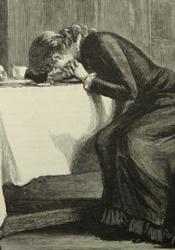The Matrimonial Causes Act of 1857
In Victorian England, adultery was the sole ground for divorce. While divorce was not technically impossible prior to the Matrimonial Causes Act of 1857, the process was incredibly expensive and complicated. It was also incredibly difficult for a woman to divorce her husband. Prior to the passing of this act, there were only four documented cases of women successfully petitioning Parliament to dissolve their marriages. These women had to have the money to pay for these proceedings, have evidence of their husbands participating in adultery, bigamy, and/or incest, and be willing to sacrifice their reputation and social status. On the surface, it doesn’t appear that much of the old proceedings changed with the Matrimonial Causes Act of 1857. The grounds for divorce were not changed, and there was still a sexual double standard. Women still had to prove aggravated adultery, while men only had to prove adultery. The Act was also supposed to permit the divorce court to sit outside of London, thus reducing the cost of divorce, but this was never put into place. What the Matrimonial Causes Act of 1857 did do, however, was make the dissolution of marriage legal. Prior to the act, Parliament had to make an exception to the law to approve divorce. Another thing this Act did was protect the future earnings and property of divorced wives. This was the first time legislation acknowledged that a wife had a right to her own property.
The literary record shows us some interesting examples of unhappy marriages and divorce that demonstrate Victorian society’s favor of husbands over wives. Charlotte Brontë’s novel Jane Eyre shows us how Mr. Rochester’s opinion on his wife’s sanity was the only one that mattered. He locked her away and took control of her property. While the novel does raise an eyebrow at his decision to attempt to marry Jane while still legally married to another, he is ultimately commended for holding onto his wife and caring for her. Other novels from the Victorian period that include divorce, such as Anne Brontë’s The Tenet of Wildfell Hall and William Thackeray’s The Newcomers show how the dissolution of a marriage was initiated by the husband.
Sources
Hager, Kelly. “‘Chipping Away at Coverture: The Matrimonial Causes Act of 1857.’” BRANCH,
https://www.branchcollective.org/?ps_articles=kelly-hager-chipping-away-at-coverture-the-ma
“Obtaining a Divorce.” UK Parliament, https://www.parliament.uk/about/living-heritage/
transformingsociety/private-lives/relationships/overview/divorce/.
Wood, Margaret. “Marriage and Divorce 19th Century Style.” Marriage and Divorce 19th Century
Style | In Custodia Legis: Law Librarians of Congress, 23 Feb. 2018,
https://blogs.loc.gov/law/2018/02/marriage-and-divorce-19th-century-style/.

